Orientation-Dependent Displacement Sensor Using an Inner Cladding Fiber Bragg Grating
Abstract
:1. Introduction
2. Fabrication and Principle of QCF-FBG
3. Experiment Results and Discussion
4. Conclusions
Acknowledgments
Author Contributions
Conflicts of Interest
References
- Jin, L.; Wang, Z.; Fang, Q.; Liu, Y.G.; Liu, B.; Kai, G.Y.; Dong, X.Y. Spectral characteristics and bend response of Bragg gratings inscribed in all-solid bandgap fibers. Opt. Exp. 2007, 15, 15555–15565. [Google Scholar] [CrossRef]
- Flockhart, G.M.H.; Macpherson, W.N.; Barton, J.S.; Jones, J.D.C. Two-axis bend measurement with Bragg gratings in multicore optical fiber. Opt. Lett. 2003, 28, 387–389. [Google Scholar] [CrossRef] [PubMed] [Green Version]
- Martinez, A.; Lai, Y.-C.; Dubov, M.; Khrushchev, I.; Bennion, I. Vector bending sensors based on fiber Bragg gratings inscribed by an infrared femtosecond laser. IEEE Lasers Electro Opt. 2005, 3, 2185–2187. [Google Scholar]
- He, Z.H.; Zhu, Y.N.; Du, H. Effect of macro-bending on resonant wavelength and intensity of long-period gratings in photonic crystal fiber. Opt. Exp. 2007, 15, 1804–1810. [Google Scholar] [CrossRef]
- Yu, Y.S.; Zhao, Z.Y.; Zhuo, Z.C.; Zheng, W.; Qian, Y.; Zhang, Y.S. Bend sensor using an embedded etched fiber Bragg grating. Microw. Opt. Technol. Lett. 2004, 43, 414–417. [Google Scholar] [CrossRef]
- Han, Y.G.; Dong, X.Y.; Lee, J.H.; Lee, S.B. Simultaneous measurement of bending and temperature based on a single sampled chirped fiber Bragg grating embedded on a flexible cantilever beam. Opt. Lett. 2006, 31, 2839–2841. [Google Scholar] [CrossRef] [PubMed]
- Shen, C.Y.; Zhong, C. Novel Temperature-insensitive fiber Bragg grating sensor for displacement measurement. Smart Mater. Struct. 2011, 170, 1–3. [Google Scholar] [CrossRef]
- Rong, Q.Z.; Qiao, X.G.; Guo, T.; Yang, H.Z.; Du, Y.Y.; Su, D.; Wang, R.H.; Feng, D.Y.; Hu, M.L.; Feng, Z.Y. Orientation-dependent inclinometer based on intermodal coupling of two-LP-modes in a polarization-maintaining photonic crystal fiber. Opt. Exp. 2013, 21, 17576–17585. [Google Scholar] [CrossRef] [PubMed]
- Chen, X.F.; Zhang, C.; Webb, D.J.; Kalli, K.; Peng, G.-D. Highly sensitive bend sensor based on Bragg Grating in eccentric core polymer fiber. IEEE. Photon. Technol. Lett. 2010, 22, 850–852. [Google Scholar] [CrossRef]
- Ju, S.; Jeong, S.; Kim, Y.; Jang, M.; Kim, O.; Han, W.T. Optical fiber bend sensor based on fiber Bragg grating in germano-silicate glass optical fiber with depressed-index structure. Proc. SPIE 2013, 8794, 87942G. [Google Scholar]
- Villatoro, J.; Newkirk, A.V.; Antoniolopez, E.; Zubia, J.; Schülzgen, A.; Amezcuacorrea, R. Ultrasensitive vector bending sensor based on multicore optical fiber. Opt. Lett. 2016, 41, 832–835. [Google Scholar] [CrossRef] [PubMed]
- Rong, Q.Z.; Qiao, X.G.; Zhang, J.; Wang, R.H.; Hu, M.-L.; Feng, Z.Y. Simultaneous measurement for displacement and temperature using Fiber Bragg Grating cladding mode based on core diameter mismatch. J. Lightwave Technol. 2012, 30, 1645–1650. [Google Scholar] [CrossRef]
- Zhou, B.; Zhang, A.P.; He, S.L.; Gu, B.B. Cladding-Mode-Recoupling-Based Tilted Fiber Bragg Grating Sensor With a Core-Diameter-Mismatched Fiber Section. IEEE Photonics J. 2011, 2, 152–157. [Google Scholar]
- Smith, K.H.; Ipson, B.L.; Lowder, T.L.; Hawkins, A.R.; Selfridge, R.H.; Schultz, S.M. Surface-relief fiber Bragg gratings for sensing applications. Appl. Opt. 2006, 45, 1669–1675. [Google Scholar] [CrossRef] [PubMed]
- Qi, T.; Xiao, S.L.; Shi, J.; Yi, L.L.; Zhou, Z.; Bi, M.H.; Hu, W.S. Cladding-Mode Backward-Recoupling-Based Displacement Sensor Incorporating Fiber Up Taper and Bragg Grating. IEEE Photonics J. 2013, 5, 7100608. [Google Scholar]
- Jin, Y.X.C.; Chan, C.; Dong, X.Y.; Zhang, Y.F. Temperature-independent bending sensor with tilted fiber Bragg grating interacting with multimode fiber. Opt. Commun. 2009, 282, 3905–3907. [Google Scholar] [CrossRef]
- Baek, S.; Jeong, Y.; Lee, B. Characteristics of short-period blazed fiber bragg gratings for use as macro-bending sensors. Appl. Opt. 2002, 41, 631–636. [Google Scholar] [CrossRef] [PubMed]
- Albert, J.; Shao, L.Y.; Caucheteur, C. Tilted fiber Bragg grating sensors. Laser Photonics Rev. 2013, 7, 83–108. [Google Scholar] [CrossRef]
- Allsop, T.; Dubov, M.; Martinez, A.; Floreani, F.; Khrushchev, I.; Webb, D.J.; Bennion, I. Bending characteristics of fiber long-period gratings with cladding index modified by femtosecond laser. J. Lightwave Technol. 2006, 24, 3147–3154. [Google Scholar] [CrossRef]
- Zhao, D.H.; Chen, X.F.; Zhou, K.M.; Zhang, L.; Bennion, L.; MacPherson, W.N.; Barton, J.S.; Jones, J.D.C. Bend sensors with direction recognition based on long-period gratings written in D-shaped fiber. Appl. Opt. 2004, 43, 5425–5428. [Google Scholar] [CrossRef] [PubMed]
- Liu, Y.; Williams, J.A.R.; Bennion, I. Optical bend sensor based on measurement of resonance mode splitting of long-period fiber grating. IEEE. Photonics Technol. Lett. 2000, 12, 531–533. [Google Scholar] [CrossRef]
- Bao, W.J.; Qiao, X.G.; Rong, Q.Z.; Hu, N.F.; Yang, H.Z.; Feng, Z.Y.; Hu, M.L. Sensing characteristics for a Fiber Bragg grating inscribed over a fiber core and cladding. IEEE. Photonics Technol. Lett. 2015, 27, 709–712. [Google Scholar] [CrossRef]
- Rong, Q.Z.; Qiao, X.G.; Guo, T.; Bao, W.J.; Su, D.; Yang, H.Z. Orientation-dependent fiber-optic accelerometer based on grating inscription over fiber cladding. Opt. Lett. 2014, 39, 6616–6619. [Google Scholar] [CrossRef] [PubMed]
- Scarcia, W.; Palma, G.; Falconi, M.C.; de Leonardis, F.; Passaro, V.M.N.; Prudenzano, F. Electromagnetic Modelling of Fiber Sensors for Low-Cost and High Sensitivity Temperature Monitoring. Sensors 2015, 15, 29855–29870. [Google Scholar] [CrossRef] [PubMed]
- Smelser, C.W.; Mihailov, S.J.; Grobnic, D. Formation of Type I-IR and Type II-IR gratings with an ultrafast IR laser and a phase mask. Opt. Exp. 2005, 13, 5377–5386. [Google Scholar] [CrossRef]
- Mihailov, S.T.; Smelser, C.W.; Grobnic, D.; Walker, R.B.; Lu, P.; Ding, H.M.; Unruh, J. Bragg Gratings Written in All-SiO2 and Ge-Doped Core Fibers With 800-nm Femtosecond Radiation and a Phase Mask. J. Lightwave Technol. 2004, 22, 94–100. [Google Scholar] [CrossRef]
- Waltermann, C.; Doering, A.; Köhring, M.; Angelmahr, M.; Schade, W. Cladding waveguide gratings in standard single-mode fiber for 3D shape sensing. Opt. Lett. 2015, 40, 3109–3112. [Google Scholar] [CrossRef] [PubMed]
- Guo, T.; Shao, L.Y.; Tam, H.Y.; Krug, P.A.; Albert, J. Tilted fiber grating accelerometer incorporating an abrupt biconical taper for cladding to core recoupling. Opt. Exp. 2009, 17, 20651–20660. [Google Scholar] [CrossRef] [PubMed]
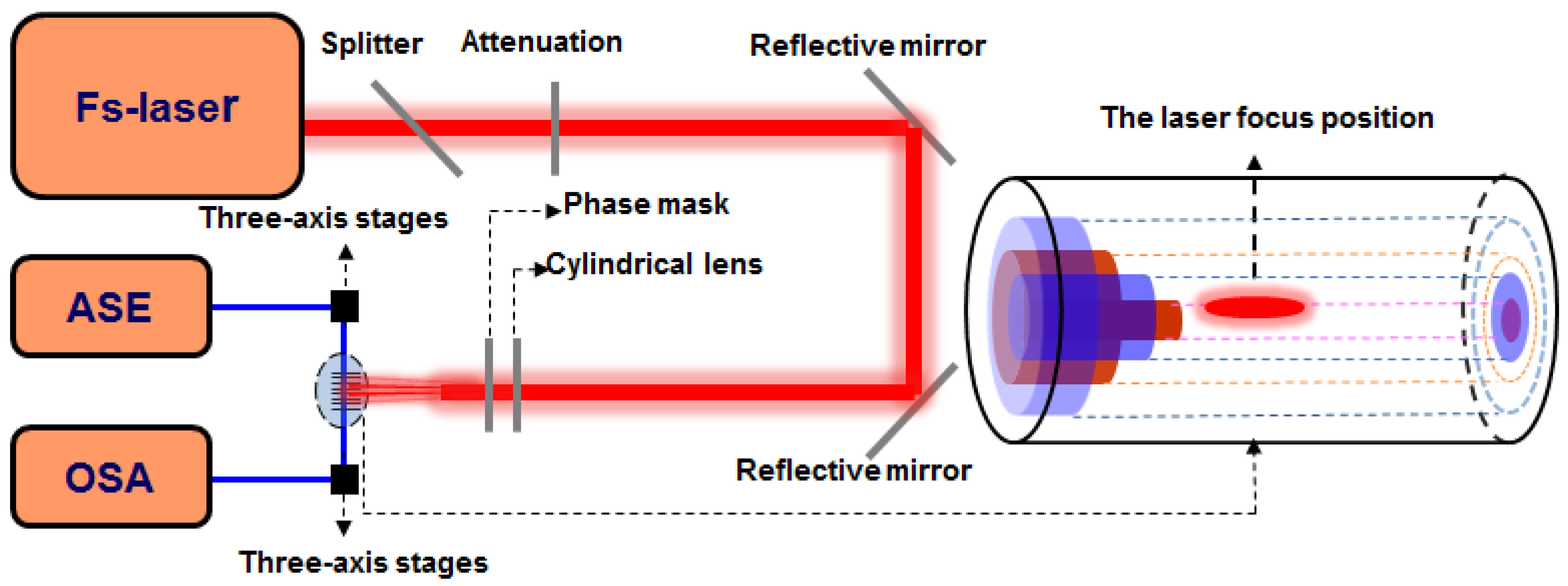

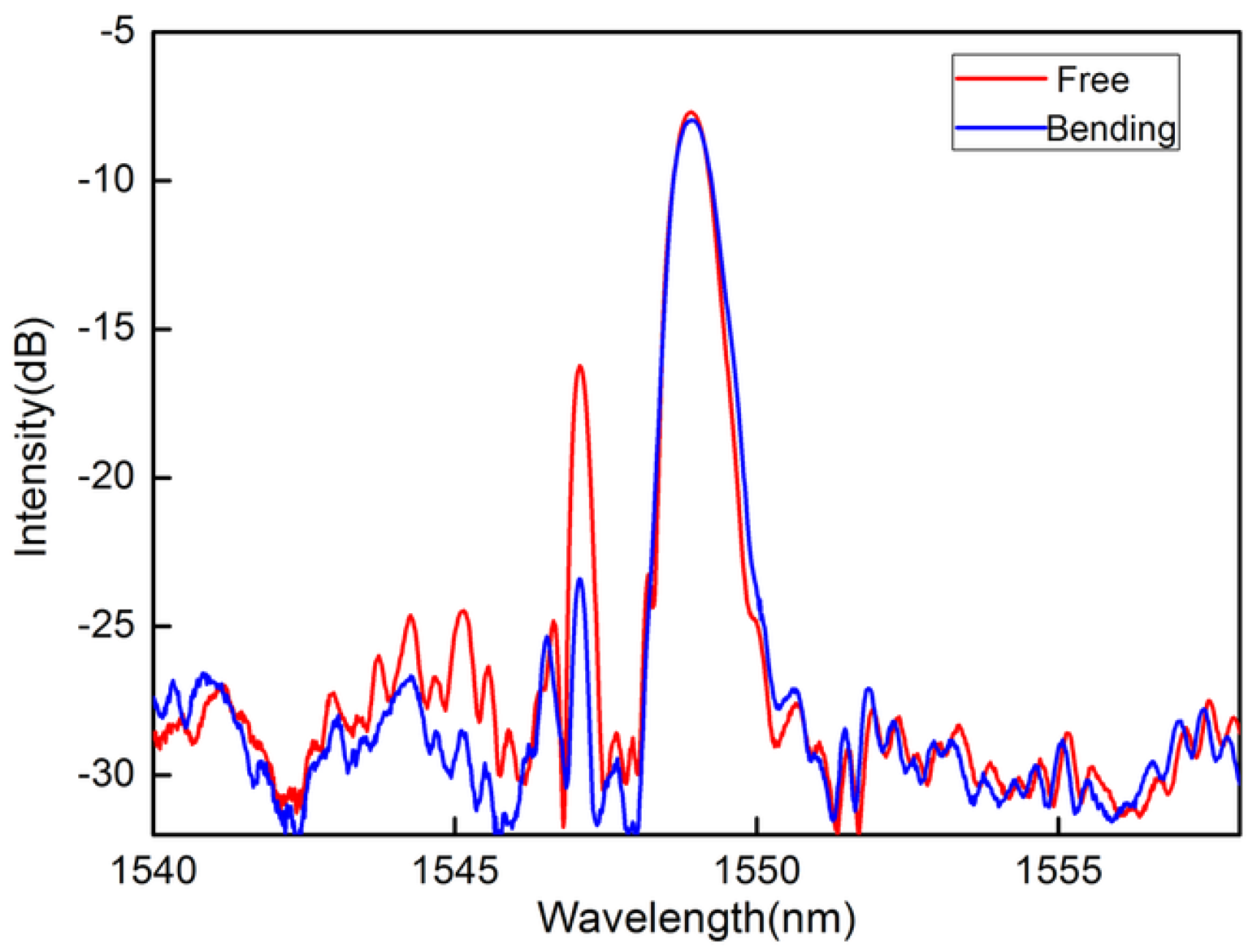
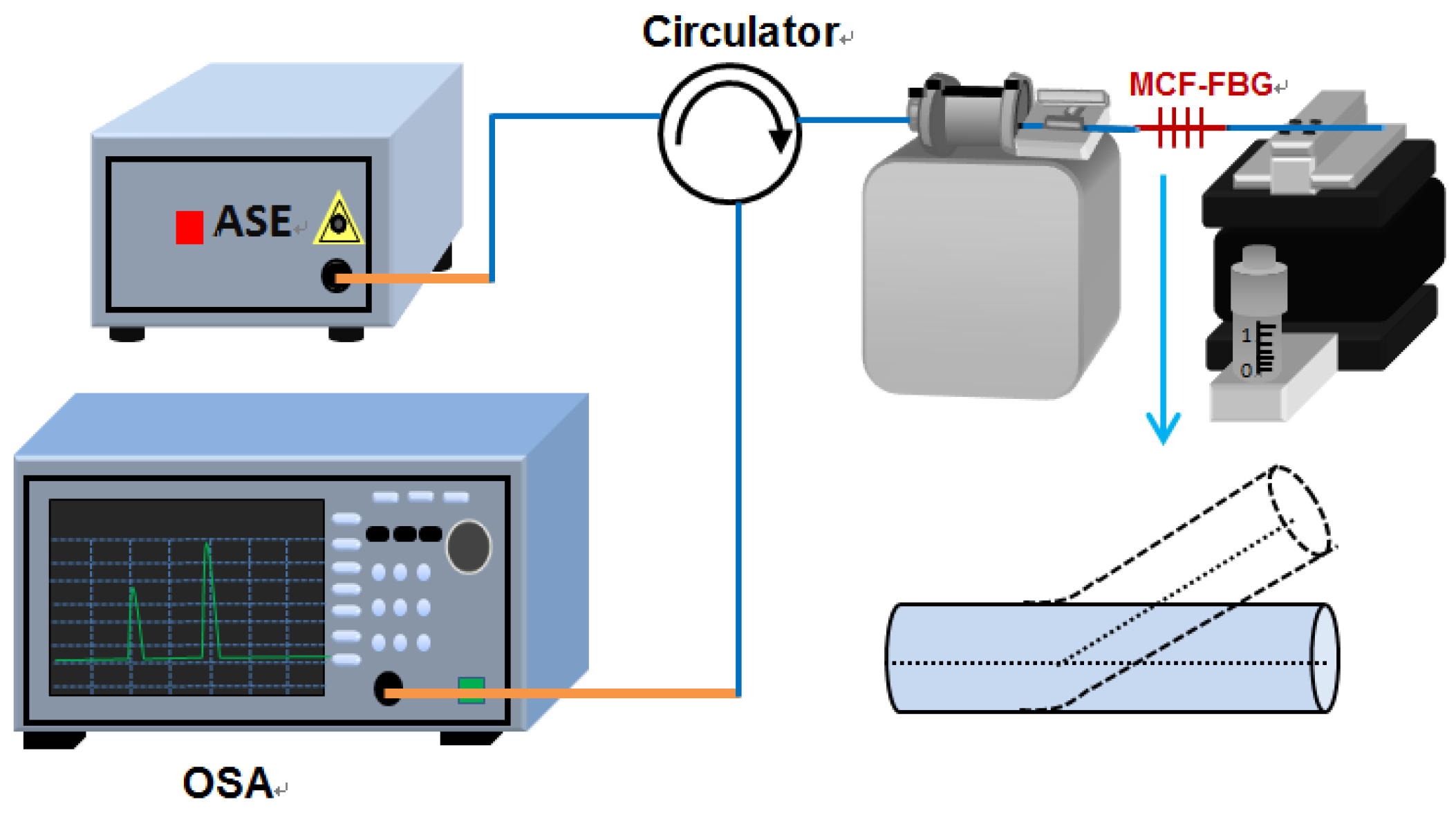
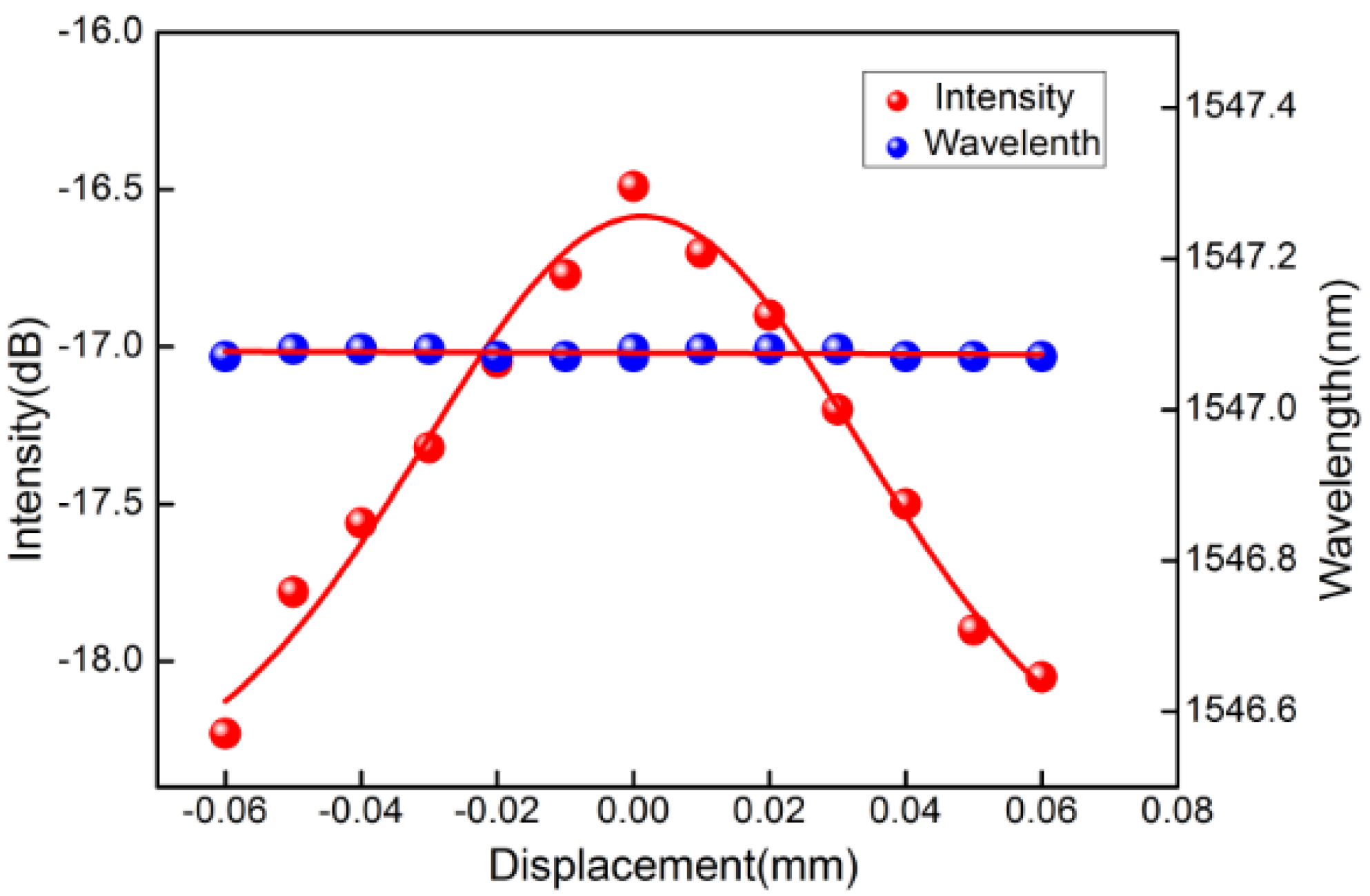

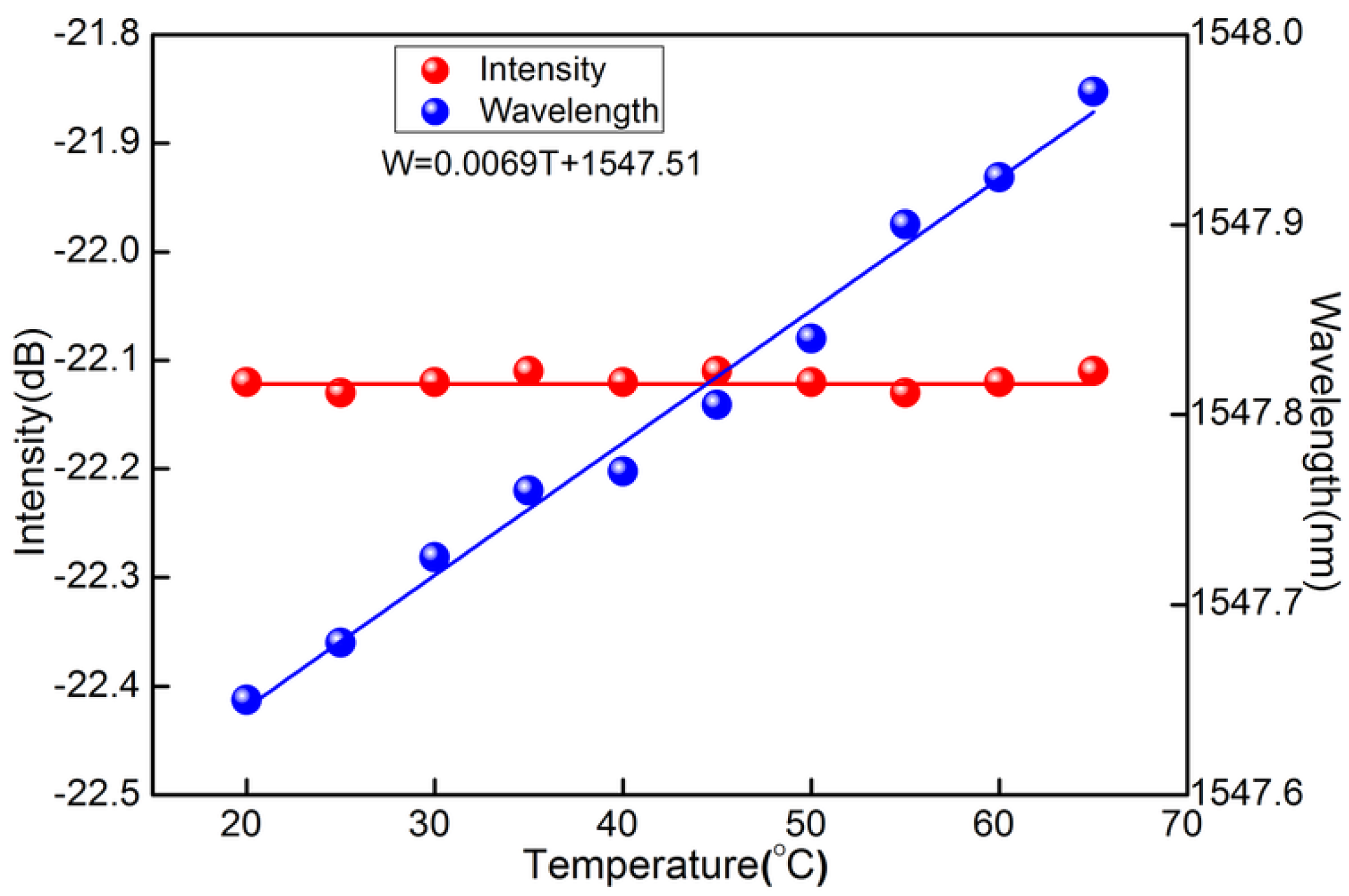
© 2016 by the authors; licensee MDPI, Basel, Switzerland. This article is an open access article distributed under the terms and conditions of the Creative Commons Attribution (CC-BY) license (http://creativecommons.org/licenses/by/4.0/).
Share and Cite
Yang, T.; Qiao, X.; Rong, Q.; Bao, W. Orientation-Dependent Displacement Sensor Using an Inner Cladding Fiber Bragg Grating. Sensors 2016, 16, 1473. https://doi.org/10.3390/s16091473
Yang T, Qiao X, Rong Q, Bao W. Orientation-Dependent Displacement Sensor Using an Inner Cladding Fiber Bragg Grating. Sensors. 2016; 16(9):1473. https://doi.org/10.3390/s16091473
Chicago/Turabian StyleYang, Tingting, Xueguang Qiao, Qiangzhou Rong, and Weijia Bao. 2016. "Orientation-Dependent Displacement Sensor Using an Inner Cladding Fiber Bragg Grating" Sensors 16, no. 9: 1473. https://doi.org/10.3390/s16091473




